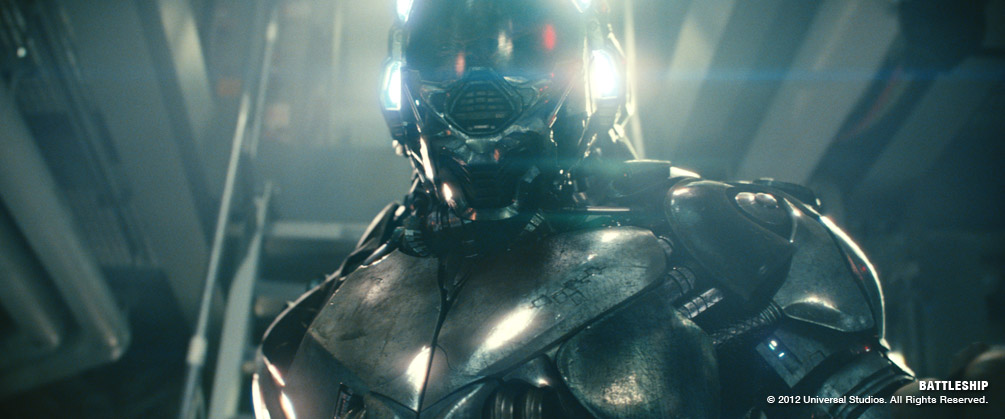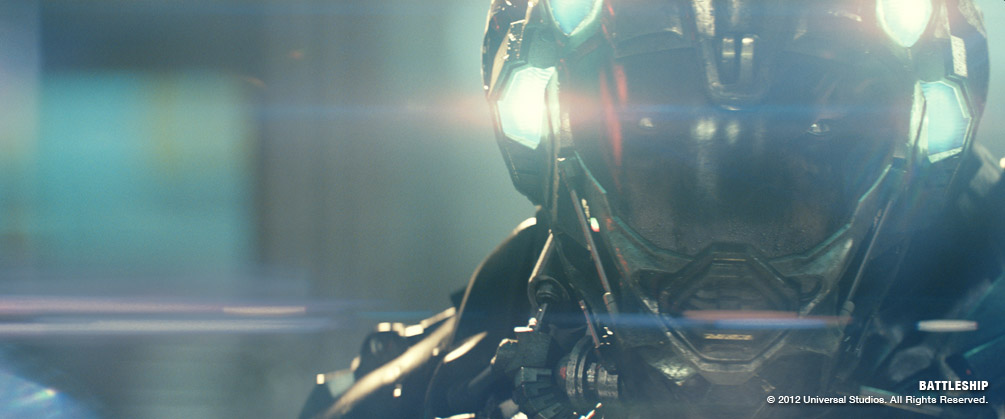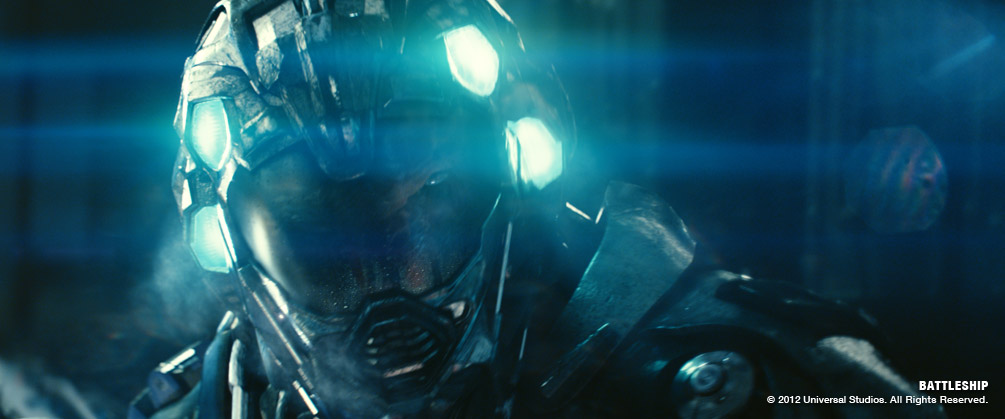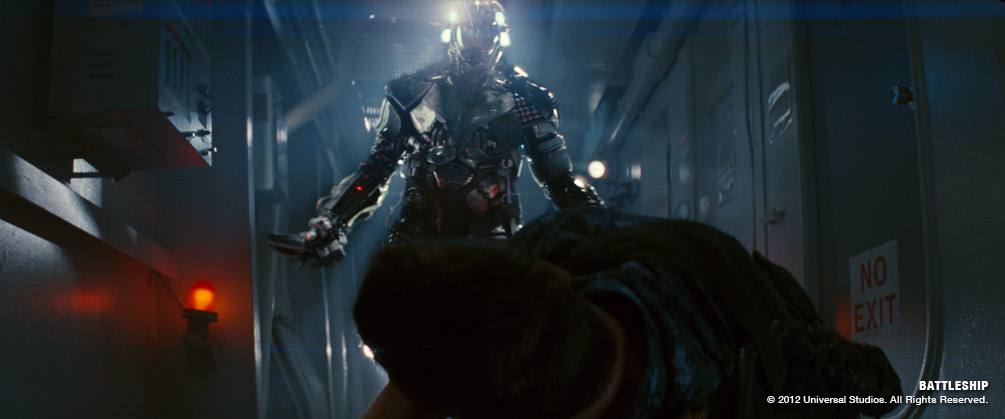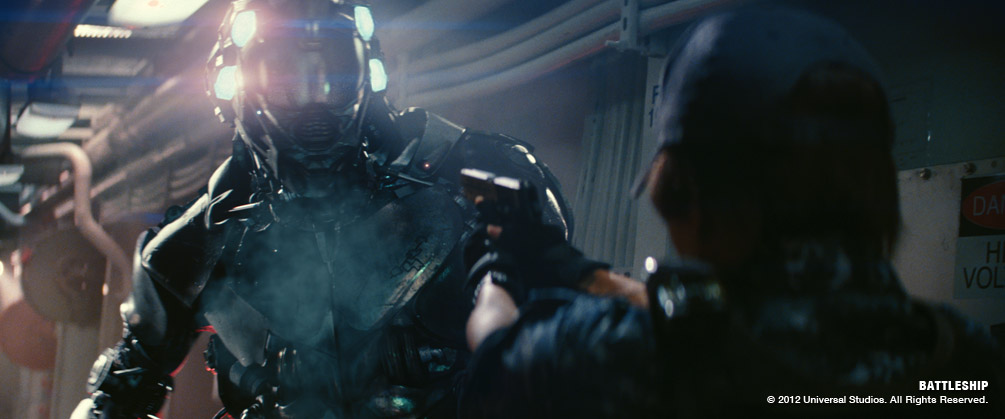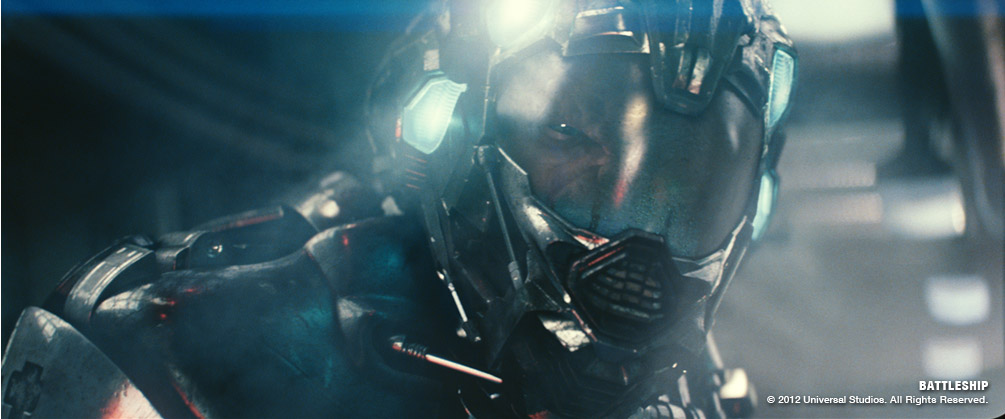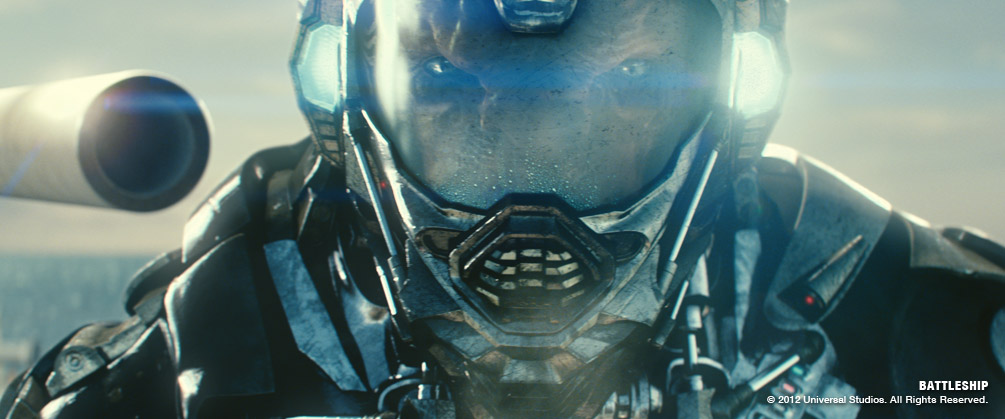Battleship Case Study
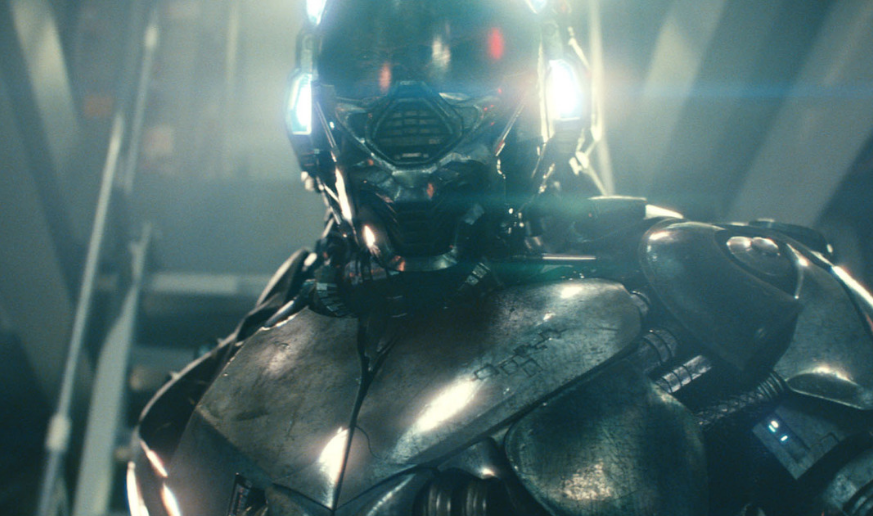
Image Engine has provided 77 shots for Peter Berg’s Battleship, the epic-scaled action-adventure film inspired by Hasbro’s classic naval combat game. Impressed by the company’s creature portfolio, Industrial Light & Magic appointed Image Engine to create the alien ‘Thug’ sequence on board the Naval Destroyer ship.
Image Engine’s background with Neill Blomkamp’s District 9 was instrumental to the award of the sequence, which required a highly specialized crew to handle the look and performance of the alien Thug. “The folks at ILM were duly interested in our creature work after the success of District 9,” recalled Visual Effects Executive Producer, Shawn Walsh. “Gretchen Libby & Scott Farrar came to Vancouver to meet our group and discuss the future of visual effects, and we had a great dialogue. When the opportunity came up to collaborate on a sequence for Battleship, we all leapt at the chance.”
In the sequence assigned to Image Engine, the Thug invades the ship and wreaks havoc in the engine room, until Petty Officer Raikes (Rihanna) ultimately blows it apart with a 54-caliber deck gun – all of which involved extensive computer generated creature and effects animation, and heavy-duty compositing.
Creating a Monster
At the initial handover, ILM supplied the work-in-progress animated turntables and rig, for Image Engine to take the Thug the rest of the way. “The look development was about 80% there at that stage, and it was over to us to finish the job, as well as handle re-designs that came about as the scene evolved,” said Image Engine’s Visual Effects Supervisor, Chris Harvey. “Initially the Thug was designed for a ‘search and destroy’ mission, which meant that it would smash apart the engine room to sabotage the ship. This mission changed part way through to reconnaissance, requiring a different approach to handling both the design and animation.” Some of the initial changes to the design brief included the anatomy of the Thug, which Image Engine adapted to become less ‘creature-like’, by replacing it’s original claw-feet with a new mechanical boot, and adding bulk to it’s legs and torso as Berg’s vision for the character evolved. “The Thug was originally designed to look like an NFL Running Back, but Berg subsequently asked us to make him look like big offensive Lineman,” commented Jeremy Stewart, Animation Lead. “The new Design brief was intended to make the Thug look bigger and heavily armored. The armor looks great, but unfortunately more armor usually means limited movement because in the real world, armor or even heavy clothing limits a person’s mobility. Animation, Rigging and Modeling really had to work together to come up with a design that looked cool but could also move.” Matching the stunt man’s dynamic performance and range of motion to the rigid armor was a tough balancing act, and the crew had to come up with multiple solutions. “We added a lot of controls to the armor which was rigged to the alien’s skin, some to give us more movement, others to lock it place,” continued Stewart. “During animation, we put a lot of consideration into how the body movements would affect the armor. Although we had motion capture for most of the shots, we had to thoroughly edit it and often completely replace it to keep the armor looking intact. The mocap was also revised give a better sense of weight and timing.”
Image Engine’s modeling and animation teams helped to drive the development of the Thug’s multi-function tool arms including a scanner, hook and a skewer, which went through a number of revisions as Stewart described, “In the original script it wasn’t intended to transform as much as it does now. It was supposed to just be a hammer that spun around if he needed the claw end. We started adding subtle mechanical movement to all the little bits of geometry on his hammer as a way to finesse the shots. Peter Berg and the animation supervisor, Glen McIntosh at ILM really liked what we were doing and kept asking for more and more till finally his hammer evolved into the transforming multi-weapon you see in the movie.” One of the transformations turns the hammer into a scanner to gather information on human technology, which according to Stewart was one of the ways in which the character’s anatomy and performance was altered to reflect his altered mission. “In the original script he destroys the ships engine by bashing it to bits with his hammer hand – when the brief changed, we decided to come up with a tool that could gather intelligence instead. Another reason for this change was because Berg really liked seeing the Thug’s tool transform and changing it to a scanner was another opportunity see more transformations. Aside from the mission change, the direction for the character was pretty consistent though… essentially the Thug is a big bad-ass monster!”
Another key design change involved revealing the Thug’s face, as Harvey recalled: “In the original concepts, its face was obscured by the visor. Later, we ran several tests where we could see the Thug’s eyes, which we animated based on stuntman Richard Cetrone’s performance during ILM’s mocap shoot. This went down very well, and ultimately the Thug’s face was fully animated in every shot.” Compositing Lead, Bernhard Kimbacher handled the majority of the look development in comp for the new visor concept. “On one hand we had to enhance the look of the visor and add some life to it, which we handled with cold breath and condensation elements and on the other hand we still had to get some of the facial expressions across while not revealing too much of the Thug,” noted Kimbacher. “In order to stay on top of our tight schedule we had to make most of these comp tricks as automated as possible, as setting it up for each shot would have taken us significantly longer. For the visor we mainly used a pass we get from lighting called ‘positional reference’. This allowed us to map different textures on the visor, which we could then animate to replicate the Thug’s breathing cycle. To read the facial animation on the Thug properly required more art directing on a shot by shot basis. Lighting provided us with separate key, fill and ambient lights as well as interior helmet lights which we could dial in on a per-shot basis to get the best mix of reading the facial feature while keeping the Thug looking mysterious behind the visor.”
The overall directive for the lighting was ‘Blingy’ said Harvey. “There were warning lights going off everywhere, with animated reflections bouncing off the suit. We had a lot of creative freedom with lighting, which meant that we could really push things artistically, rather than being bound to the original plates.”
Rob Bourgeault, Lighting Lead, was responsible for coming up with the creative solution to enhance and stylize the overall look of the character. “This was done by over-accentuating the reflective and specular properties of the asset shader through selective placement of multiple reflection cards in each scene”, he explained. “The resulting output from lighting was visually incorrect as compared to the plate with cheated intensities and positions, however it gave compositing the necessary range to apply a post processing effect to the renders and thereby achieve the desired stylized look. Most of the artistic license existed in painting and shaping the character with very intense reflection cards to achieve the result that Peter Berg was looking for. We were often requested to add additional reflection cards to accentuate the key and rim reflections of the character. This was done with special attention to the plate, looking for any opportunity to enhance the interactive nature of the character within its surrounding environment.”
Thug Destruction
Toward the climactic end of the sequence, the Thug is lured to the deck to be destroyed. The details of its demise went through substantial revisions during postproduction. “We finaled two shots of the Thug destruction, based on previz and postviz in which the Thug was engulfed in fire after it was hit by the deck gun,” related Harvey, “but at that stage, Berg decided he wanted to see it torn to pieces, so we came up with a much more dramatic concept where the Thug’s arm ripped off and his visor shattered – and ended up with a shot that became almost entirely digital.”
Lead FX TD, Jacob Clark and Senior Compositor, Daniel Elophe went back to the drawing board to create the computer-generated destruction, which took several months to complete. The biggest challenge came from the fact that the shot was split between two cameras, with each of the two camera angles presenting unique hurdles that had to be addressed separately, but still fit together as one solid action sequence.
“With regard to the Thug destruction shots, nothing quite like this had been undertaken at Image Engine before,” said Clark. “This was a very ambitious shot from day one, involving a fully computer generated character in broad daylight being torn apart in slow motion by a fire spewing cannon. The fire and smoke not only occupied a large section of the screen, but the fire had to interact with the intricately detailed armor of the Thug, which had almost 800 different interlocking metal shapes.”
It was clear from the beginning that the project required some heavy hitting fx power, and Houdini was chosen to handle the job, as Clark explained, “I have had a long relationship with SideFX software and have been very happy with their product Houdini in the past. With this in mind, I approached SideFX to use their new Houdini 12 beta version, which has great tools for addressing our volumetric needs in development. Our IT team was able to quickly integrate into the software into the Image Engine film pipeline. In the end, we used Houdini’s new volumetric technology quite extensively in the production of the Battleship Thug destruction. By the time the shot had finaled we had run over 80 different simulations of Fire and Smoke in the scene. With all of these simulation tests coming through, I have to mention Senior Compositor, Daniel Elophe’s fantastic ability to gather all of this together for the final completion. Each fx render had multiple passes, and if you were to add all these passes up with the renders of the Thug, Daniel was able to corral well over 100 different image renders to complete the shot!”
According to Elophe, the resulting shots were well worth the time and effort, and ultimately helped to strengthen the company’s fire fx pipeline. “The most challenging aspect was that the fire needed to interact with the breaking thug, and move around/through pieces. There was a good solid month of back and forth, brainstorming and trying lots of variations of fire within the context of the explosion with Jacob running fire simulations from various body parts of the Thug. For me as an artist, this was the most rewarding part of the process, working extensively with Jacob and being given a lot of creativity and flexibility from Chris and our producer, Vera Zivny to explore what would work well.”
Harvey puts the final success of the sequence down to the collective strength of the individuals on his team. “We were lucky enough to be able to assemble the ideal crew for the show. All of the lead artists and production team had come from shows like District 9 and The Thing, and each played an instrumental role in making the sequence spectacular. Working with Supervisor Pablo Helman and Animation Director Glen McIntosh at ILM was also very cool. The approach was very collaborative all the way through, and we were adapting material supplied by ILM to our own systems and packaging it back up for ILM to use in their shots, which was an ideal way to work.” Vera Zivny added: “From the very beginning, it was the team effort and mutual creative respect between ILM and Image Engine that made for a sweet-looking sequence.”


